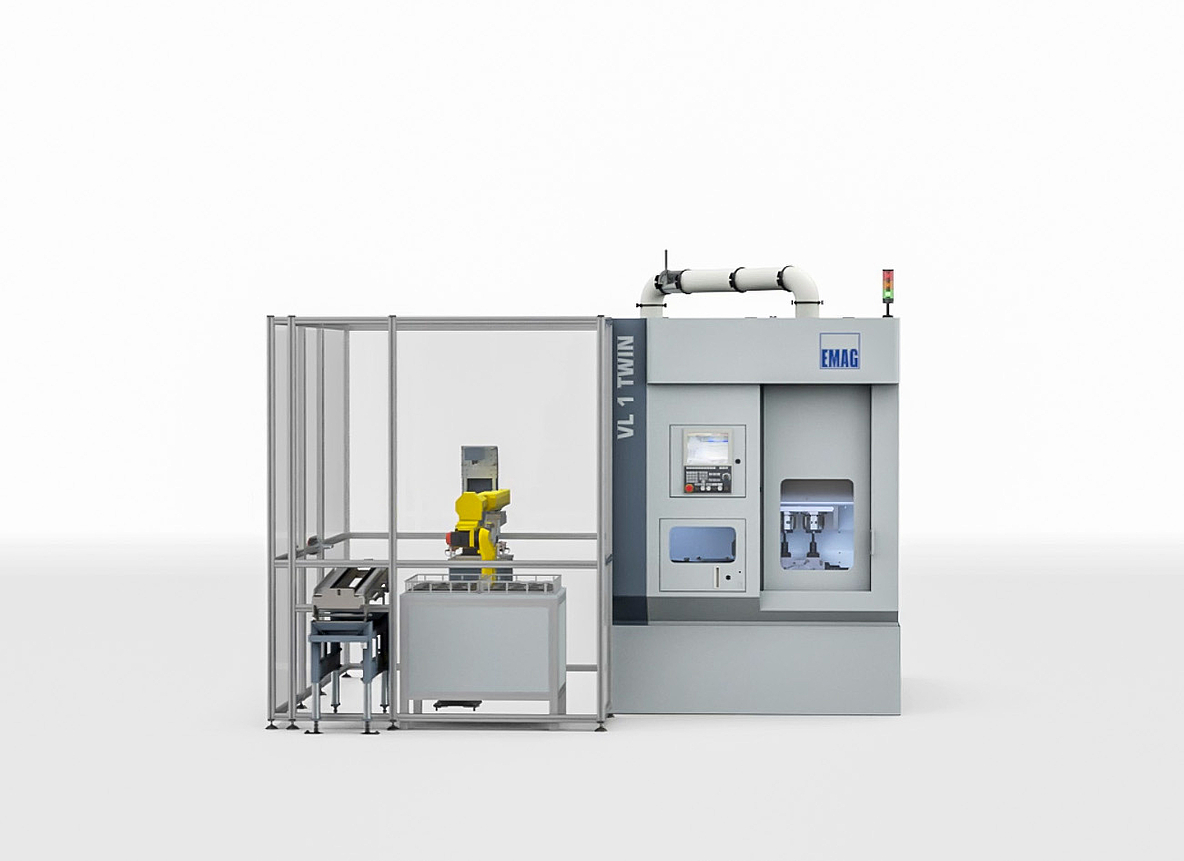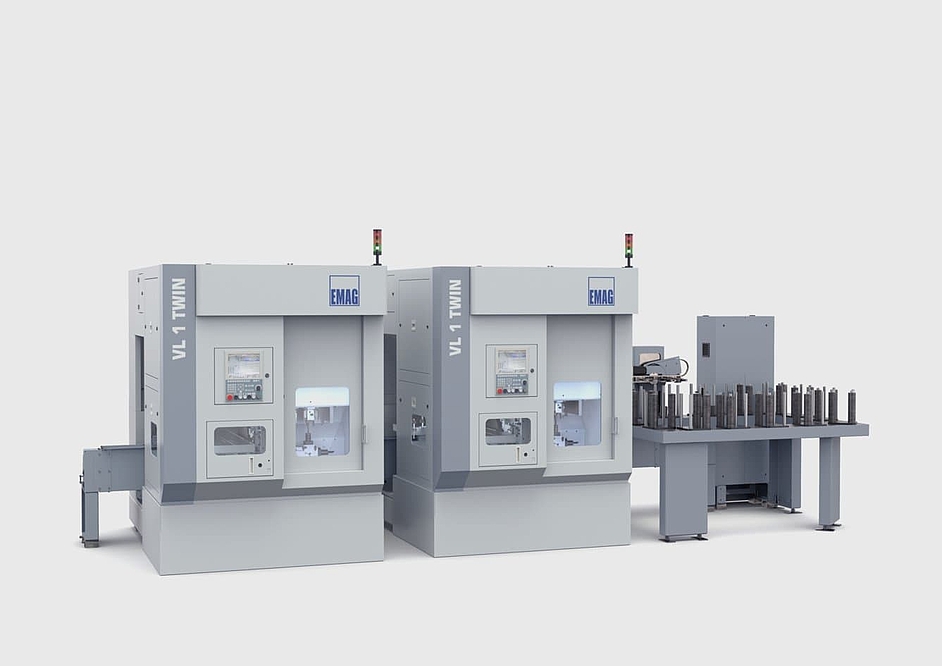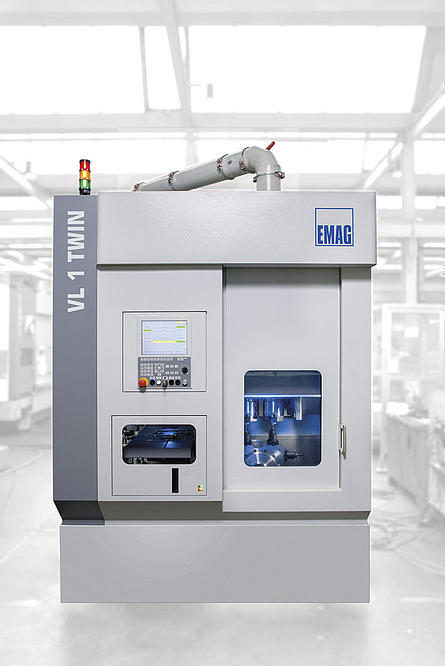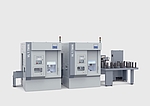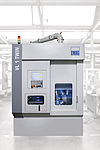06/15/2020 - Oliver Hagenlocher - Press
VL 1 TWIN from EMAG: Drastically Lower Unit Cost for Bevel Gears
Bevel gears found in passenger vehicles are mass-produced. Supply companies produce these gears, essential for differentials, by the million—and it’s no wonder, since there are four of these in every differential. The number of all-wheel-drive vehicles, which include two differentials each, is continuing to rise leading to an increase in bevel gear output volume, and bringing more attention to the production process for this part. Supply companies are searching for new mechanical engineering solutions that guarantee considerably lower costs per piece and a consistently high quality. With its twin-spindle pick-up turning machine—VL 1 TWIN—EMAG has developed a solution: It simultaneously machines two identical bevel gears at high speed within the same machining area. A robot cell and swivel table can easily load this machine. All this brings the cycle time down to 4.5 seconds.
The demand for all-wheel-drive vehicles is growing. In Germany, for instance, they now represent approximately 20 percent of new vehicle registrations. In other countries, such as Sweden and Switzerland, the figure is even higher. This development implies a sharp increase in the number of bevel gears produced, which is subject to a growing cost pressure as are all mass-produced workpieces in the automotive industry. The production process generally starts with a sophisticated forging procedure during which the component obtains its characteristic bevel gear teeth. This is followed by various turning processes: the taper face opposite the serration, a small offset on the taper face, the inner bore and the end face are all produced this way. Whether these processes are performed directly within the scope of a final hard machining operation or each component is first soft turned and then hard turned depends on the manufacturer's specific production solution. “Regardless, it’s about managing very large quantities cost-efficiently, quickly, and free of defects,” explains Daniele Loporchio, Technical Sales Manager at EMAG. “That is exactly why we designed the VL 1 TWIN. The machine is perfect for soft and hard machining of a wide variety of bevel gears up to 75 millimeters in diameter (3 in).”
Cycle Time of just 20 Seconds
The basic principle of this pick-up turning center plays a decisive role. It features two pick-up spindles (9.9 kW/136 Nm at 40% duty cycle) that are used to always machine two identical bevel gears in parallel at high speed (OP 10 – OP 10). The two spindles load and unload the machining area in just five to six seconds. The machining steps described above are then performed successively and in a single clamping operation with a total cycle time of about 25 to 40 seconds (depending on type and size of part). The average chip-to-chip time is just under six seconds. A special clamping solution reproduces the negative image of the component’s gearing and holds it firmly in place for the entire time. Additionally, the VL 1 TWIN is able to drill into solid material, which is how the bevel gear’s center bore is produced.
This machines whole approach leads to fast production and high output quantities, while significantly reducing the price per spindle with rigorous cost controls – contributing to the low unit costs.
Focus on Component Quality
With EMAG equipment, there are a range of standard features that ensure component quality and reliability. For instance, the VL 1 TWIN has a machine base made of MINERALIT®, which significantly reduces vibrations during the turning process, leading to longer tool life and lower tool costs. Headstocks can traverse autonomously, allowing the diameter and length (X/Z directions) of both components to be adjusted independently of one another if there any deviations, e.g., following the change of an indexable insert. The wear-free linear drive in the X-axis, including the direct distance measuring systems, is equally important. It has an acceleration of 8 m/s2 (1,575 fpm) with precise long-term accuracy. The roller guides in all linear axes guarantee further precision.
Loading the VL 1 TWIN with a Robot
EMAG develops the actual production task for the bevel gear including its automation and interlinking in a very flexible manner and adapts it to the customer's needs. The technical starting point of the parts flow is the integrated pick-up automation system, which is responsible for the flow of parts within the machine. In order to increase the production volume, EMAG's developers can combine the VL 1 TWIN with a powerful robot cell and a swivel table. In this case, the gripper is precisely adapted to the shape of the component. Pre-positioned component containers simplify transport as well as loading and unloading. This allows the cycle time to drop all the way to 4.5 seconds and individual process flows are easily reproducible. Additional processes, such as measuring, marking and cleaning, can be integrated in the same cycle time.
In addition to this, two VL 1 TWINs can be loaded with the robot cell mentioned earlier or with EMAG's TrackMotion automation system (OP 10 – OP 10, OP 10 – OP 10). In the latter case, the TransLift (a lifting and rotating device with an electric gripper) picks up raw parts from a feeding conveyor and transports them to the machines. Both machines are loaded very quickly—a solution for four spindles that is both powerful and very compact.
Relevant for Electric Drives
Low investment and production costs, short cycle times and high process reliability—provide a base that allow machinery manufacturers to feel equipped to produce bevel gears. “From classic combustion engines to purely electric drives, differentials remain relevant regardless of drive type. Whoever wants to modernize their production now and prepare for growing unit volumes definitely ought to take a closer look at this technology,” concludes Loporchio emphatically. “We’re convinced that the VL 1 TWIN is an ideal solution for many bevel gear manufacturers.”
Images
Downloads
Contact

Oliver Hagenlocher
Area
Press and Communication

